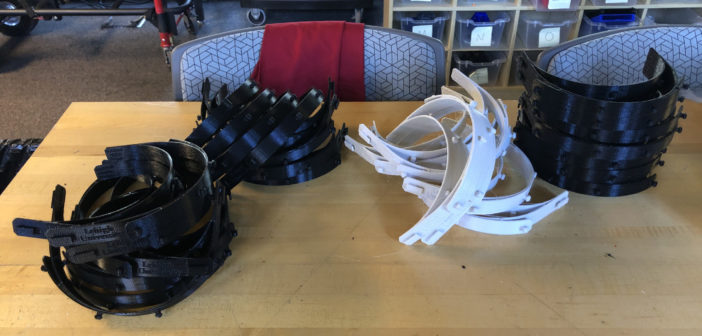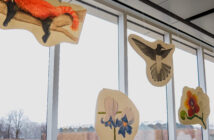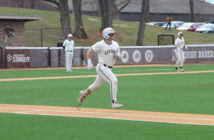With more emphasis than ever on the supply of protective equipment for health care professionals, universities, nonprofits and businesses around the nation have figured out creative ways to help.
3-D printing has proven to be one viable way to increase the production of this equipment — and Lehigh is taking advantage.
Using the 3-D printers in Wilbur Powerhouse and the laser cutters in the Design Labs on Mountaintop, Brian Slocum, Michael Moore, and Trevor Verdonik, all Wilbur staff members, have manufactured and donated 1,500 face shields for local hospitals in the Lehigh Valley. They plan to make about 2,000 more over the next three weeks.
Among the organizations receiving the shields are Lehigh Valley Hospital, Good Shepherd Hospital and the Lehigh and Northampton County Emergency Management Agencies (EMAs). The EMAs distribute the shields to first responders such as EMS, police and fire, as well as nursing homes and others in need.
Brian Slocum, managing director of Lehigh’s Wilbur Powerhouse and design labs, said he was contacted in March by hospitals who knew of Lehigh’s 3-D printing capabilities and were in need of more personal protective equipment, or PPE.
“We were exploring this to maybe send to New York, not knowing that we would have the need right here, in the Lehigh Valley,” Slocum said.
After receiving approval from the university, Slocum said he began working with Moore and Verdonik, assistant managers of Wilbur Powerhouse, to 3-D print and laser cut the face shields.
Slocum, Moore and Verdonik developed the prototype for the face shields with the help of a Lehigh alum at Knoll Inc. in East Greenville, Pennsylvania. Slocum said they began with a vetted design for face shields from the Czech Republic, which they modified to meet the needs of hospitals.
The face shields consist of five components, Slocum said. These include a headband which lays across the forehead, a neoprene comfort band and roof which wrap over the face shield, an adjustable neoprene strap in the back, the clear PET plastic shield and a 3-D printed component at the bottom of the shield which curves the plastic to the face, he said.
Verdonik oversees the 3-D printing process at Wilbur, while Moore works at Mountaintop doing the laser cutting. Slocum serves as the project manager and delivers the shields to the hospitals.
These face shields are designed to be washed and reused, and many doctors who have received the shields said that they are tremendously more comfortable than the commercially available shields.
“I’ve heard that they’ve been ‘fighting’ over the ones that we’re providing,” Slocum said.
Verdonik’s wife, who is a physician assistant, can attest to the shield’s quality. Verdonik said she was one of the primary reasons why he was excited to start this project.
Moore and Slocum, too, said this project has proved to be impactful.
“You sit back and ask, ‘What can I do in this crisis,’ and it’s nice to be able to at least do something,” Slocum said. “You don’t feel quite so inept.”
Moore said being able to physically work on this project has helped him with the negative mental effects brought by social distancing.
Wilbur Powerhouse already had the filament necessary for 3-D printing, but Slocum said he needed to source the neoprene and PET plastic for the face shields. DuPont chemical company has donated an additional 1,000-foot roll of PET plastic to Lehigh, he said.
This project has been fully funded by Lehigh, but they are relying on donations of materials to continue manufacturing once the budget is exhausted. However, Lehigh has launched a crowdfunding campaign to help raise $5,000 so they can continue. They’ve also shared their design so other universities can continue to help.
The face shields are not replacements for face masks, and are intended to be worn in conjunction with an N95 respirator, Slocum said. He said the face shield protects the eyes and most of the face from any droplets, which a mask does not.
Slocum, Moore and Verdonik are the only people working to produce the masks, but volunteers from the Lehigh Valley Health Network have helped to assemble the masks, Slocum said.
Tim Docherty, director of occupational safety and health management at LVHN, and Frank Hyland, executive director of Good Shepherd, said they are appreciative of the face shields Lehigh has provided.
“I’m truly appreciative of the phenomenal generosity, innovation and expertise that the Lehigh University school of engineering has offered,” Docherty said. “We certainly want to extend our gratitude to the entire Lehigh community.”
Good Shepherd has been getting out-of-state referrals for rehabilitation, making the demand for face shields much higher, Hyland said.
Slocum said in the coming weeks, face shields will be sent to Lehigh and Northampton County emergency agencies, so that they may be distributed to first responders, nursing homes and doctor offices throughout the area.






Comment policy
Comments posted to The Brown and White website are reviewed by a moderator before being approved. Incendiary speech or harassing language, including comments targeted at individuals, may be deemed unacceptable and not published. Spam and other soliciting will also be declined.
The Brown and White also reserves the right to not publish entirely anonymous comments.